You recently foreclosed, and now you have taken possession of the property. Then you notice a foul odor from the property. After more research, you learn there is a tank on the adjacent property that is leaking and that you suspect the property has soil contamination, as well as that charming smell.
That’s a nuisance. Not the common use of the word, but the actual legal definition under California Civil Code Section 3479 which is defined as: “Anything which is injurious to health, including, but not limited to, the illegal sale of controlled substances, or is indecent or offensive to the senses, or an obstruction to the free use of property, so as to interfere with the comfortable enjoyment of life or property, or unlawfully obstructs the free passage or use, in the customary manner, of any navigable lake, or river, bay, stream, canal, or basin, or any public park, square, street, or highway, is a nuisance.”
“Offensive to the senses” sounds pretty broad, but is not referring to the perceiver’s particular sensibilities but to the five physical senses of sight, smell, sound etc. Examples include: noise, vibrations, foul odors, pests, smoke, asbestos, tree roots and soil contamination.
TYPES OF NUISANCES:
There are public nuisances and private nuisances, and they can be permanent or continuing in nature. A public nuisance affects a community or neighborhood and plaintiffs must show that a defendant’s acts are likely to cause a significant invasion of a public right. If it’s not considered a public nuisance, then it is a private nuisance. To sue on a private nuisance theory, the plaintiff must prove an injury to the use and enjoyment of his or her land.
In rare circumstances, a nuisance can be both private and public. For example, if the owner of a lot abutting on a street has an easement or right of way over it. An impairment of that property right would constitute both a private and a public nuisance.
Usually a permanent nuisance cannot be abated, meaning it will exist indefinitely (until torn down), and therefore it has caused a permanent injury. California caselaw examples of a permanent nuisance include: an encroaching building, a steam railroad operating over plaintiff’s land, or the re-grading of a street for a rail system.
A continuing nuisance, such as constant noise, vibration, or foul odors, refers to the continuing damages caused by the condition – not the acts causing the damage. For example, if there is a runoff of chemicals or flooding to your property, which may be ongoing, it could have been caused by a one-time occurrence, such a damage to an adjacent pipe or dam that caused the runoff – this is not a continuing nuisance but a permanent one.
WHAT CAN YOU DO ABOUT A NUISANCE?
The injured party can either seek to abate, or enjoin the nuisance or else recover money damages.
A subsequent owner can sue a prior possessor of property for creating a continuing nuisance. Uses of a commercial building can change over the years and the building next door that looks like another office building may very well have been an auto repair shop at one time.
ABATEMENT
Abatement of the nuisance usually is a demand to remove it. This means tearing down the encroaching structure, or it could be repaired. In Palo Alto, there was a legendary case over a “historical” house that had over a decade of litigation. The Juana Briones House, believed to be constructed of adobe in the 1840’s, suffered major damage in the Loma Prieta earthquake of 1989. The owners lacked the money to restore it and ironically, a Palo Alto city inspector declared the building a public nuisance and informed the owners that it had to be demolished or repaired. The irony was that the City then denied the owner’s application of demolition permits, which was what the decade of litigation was over. [Friends of the Juana Briones House v. City of Palo Alto, Oct. 27, 2010]
GETTING AN INJUNCTION
If it’s a continuing nuisance, such as noise, an injunction becomes the most likely remedy. In California, the first step to obtaining an injunction is to file a lawsuit in the state court and seek a Temporary Restraining Order (TRO), which lasts for a couple of weeks. Before the expiration of the TRO, the Court will set a hearing called an Order to Show Cause why a preliminary injunction should not be issued. If the Plaintiff prevails at that hearing, the preliminary injunction will stay in place for the duration of the lawsuit. The Plaintiff may be required to post a bond. If the Plaintiff prevails on the underlying lawsuit, the injunction could become a permanent injunction.
CONCLUSION
Once you have discovered the nuisance, you have only limited time to seek some of the remedies above. The statute of limitations for the recovery of damages to property caused by a nuisance is generally three years. The limitations period is two years to recover damages for personal injury which is the result of the nuisance. Once the owner is aware of the nuisance, or should have been aware of the nuisance (i.e., a reasonable person would have noticed the condition), the clock starts running on the statute of limitations.
Don’t delay!




